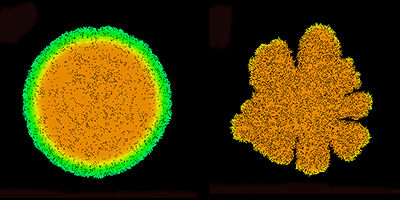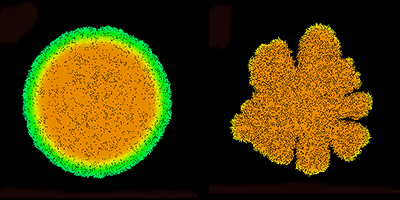Pushy Cells
Take a close look at any surface—teeth, water pipes, the kitchen counter—and chances are you will find a growing microbial colony. Some surface bacteria are useful, such as algal colonies on rocks that provide food for fish, but they can also be dangerous, causing infections in humans. In Physical Review Letters, Fred Farrell at the University of Edinburgh, UK, and colleagues present simulations that offer a new view on how bacterial colonies grow on surfaces. The simulations suggest that when bacteria stick to soft surfaces, growth is primarily determined by pushing forces between bacterial cells—and not the migration of cells and diffusion of nutrients, as was previously thought.
Farrell et al. focus on nonmotile bacteria, which often adhere to the surface on which they grow. These bacteria can’t actively move towards food, so growth tends to occur at the colony edges where nutrients are available. To investigate how nutrient diffusion and mechanical cell–cell interactions affect the shape and growth speed of bacterial colonies, Farrell et al. simulated the growth of a single cell on a solid surface into a full colony with a model that took into account both factors.
The group found that, as in nature, both spherical- and branched-shaped colonies could occur. The deciding factors for colony shape and growth rate were the rate of nutrient uptake and the magnitude of the forces exerted by the cells on each other, while the effects of nutrient diffusion were marginal. The results may apply to tissue or cancer cell growth, where the high pressures exerted by cells on their neighbors can influence growth and death rates. – Katherine Thomas





